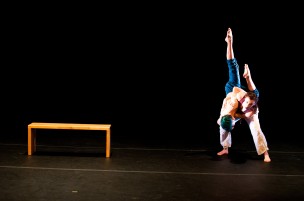The annual Spring Senior Dance Thesis Concert showcased dances inspired by unique and personal ideas, and produced performances stemming from an elegant performance about history to a spastic collection of movements about mental illness and disease. Seniors Elle Bayles, Emily Weitzman, Emily Jones, Sally Williams, Sierra Livious, and Naya Samuel are the six brave dancers who presented their theses in the ’92 Theater this past weekend. Ranging from whimsical and joyful to uncomfortable and distressing, these theses each had their own personal characteristics and backstories that made each one unique. The music went from static noise to orchestral music, sometimes within a single piece, and every movement was representative of the message that each senior conveyed through their dance.
Williams’ piece opened the show and thrust the audience into a world of frantic actions, disjointed sounds, and unnatural movements from the dancers.
“My thesis as a whole is looking at the establishment of bodies at the intersection of dance and illness,” Williams said. “With my own choreographic work, this piece is looking into Alzheimer’s dementia and the experiences behind that disease.”
Williams conveyed feelings of hopelessness and solidarity through her dance, with the dancers moving separately with seemingly random actions, yet simultaneously utilizing the same movements and slowly coming together as the performance continued.
Weitzman took on the idea of non-space in her performance. Only three dancers and two benches were set on the stage, and, throughout the piece, the dancers represented objects and the interrelationship between people and their spaces.
“Can we attach meaning to places the way we attach meaning to people?” Weitzman asked. “And how do people, objects, places, and non-places become home?”
These questions were the core of her performance, and though the questions are serious and intense, her portrayal and hopeful answer to them was quirky and a joy to watch.
Following Weitzman’s piece was Livious’ thesis; her goal was to explore diverse kinesthetic elements of the body. Livious found inspiration through perceiving the body as a machine.
“[The idea is that] efficient movement would lead to less unnecessary usage of the body and, therefore, reduce the chance of injury,” Livious said.
Full of power, the dancers moved as a unified force to pounding beats, becoming a machine of dance and energy.
Contrasting directly to Livious’ piece was Bayles’ performance, which began with bursting electronic music, crazy patterned tights, and extremely erratic movements. Being both a psychology and dance major, Bayles focused on how psychological therapies relate to choreographic processes. This ideology produced a performance that changed rapidly throughout, going from electronic movement to a recording of a man’s voice to smooth jazz. Bayles’ performance was frantic, unified, and grabbed the audience’s attention.
Finishing up the evening in the ’92 Theater was Samuel’s piece, which was also inspired by two majors: American Studies and dance.
“Specifically, I am focusing on how our constructed identities and personal histories affect our individual ways of seeing,” Samuel said. “By putting the physical body on display and in focus, live performance can challenge the perceptions and expectations the audience may have.”
This performance was beautiful, from the simple and elegant costumes to the gracefulness of each dance movement into the next. A plethora of voice recordings were heard throughout the piece, adding to the sense of introspection and history.
After Samuel’s piece was finished, the audience was asked to venture to the Alpha Delta Phi house, where Jones was hosting her site-specific performance. From location alone, Jones’ piece differed from the other performances that evening. Rather than using a stage, she had dancers spread out throughout the entire house, dancing to different music in different locations as the audience meandered around from room to room. Jones aimed to make the idea of dance more accessible by having the audience interact with the dancers, often joining in and waltzing down a hallway.
Each piece had a personality of its own, representing the senior who choreographed and worked tirelessly to produce them. They encompassed four years of learning and showcased the personal route that each senior has taken to arrive at the end of their Wesleyan dance careers.

Comments are closed